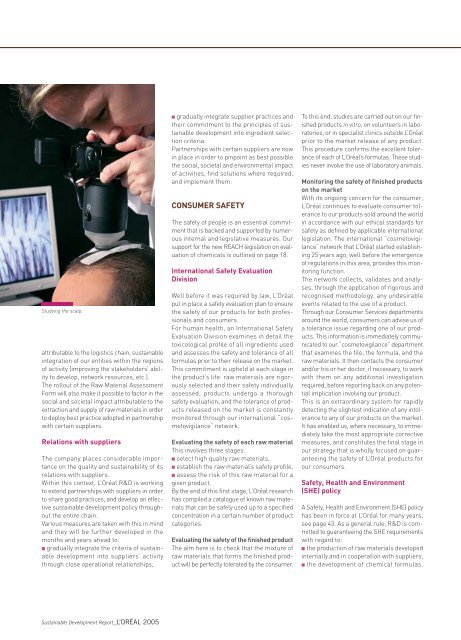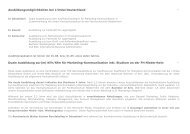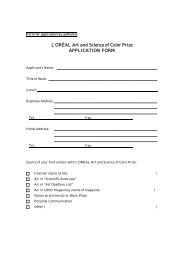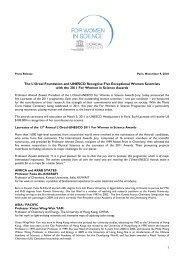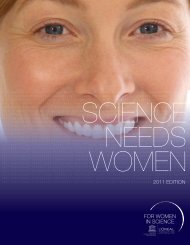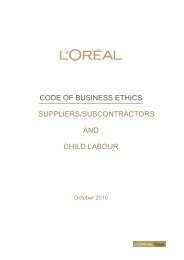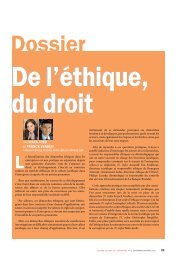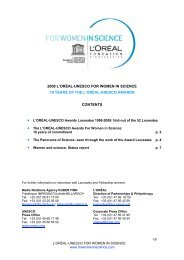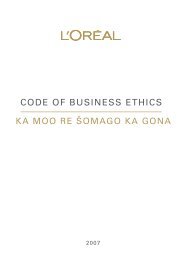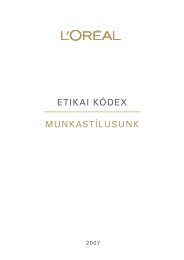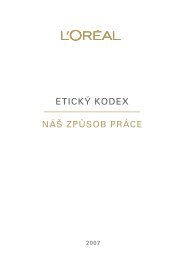2005 SUSTAINABLE DEVELOPMENT REPORT
2005 SUSTAINABLE DEVELOPMENT REPORT
2005 SUSTAINABLE DEVELOPMENT REPORT
You also want an ePaper? Increase the reach of your titles
YUMPU automatically turns print PDFs into web optimized ePapers that Google loves.
Studying the scalp.<br />
attributable to the logistics chain, sustainable<br />
integration of our entities within the regions<br />
of activity (improving the stakeholders’ ability<br />
to develop, network resources, etc.).<br />
The rollout of the Raw Material Assessment<br />
Form will also make it possible to factor in the<br />
social and societal impact attributable to the<br />
extraction and supply of raw materials in order<br />
to deploy best practice adopted in partnership<br />
with certain suppliers.<br />
Relations with suppliers<br />
The company places considerable importance<br />
on the quality and sustainability of its<br />
relations with suppliers.<br />
Within this context, L’Oréal R&D is working<br />
to extend partnerships with suppliers in order<br />
to share good practices, and develop an effective<br />
sustainable development policy throughout<br />
the entire chain.<br />
Various measures are taken with this in mind<br />
and they will be further developed in the<br />
months and years ahead to:<br />
■ gradually integrate the criteria of sustainable<br />
development into suppliers’ activity<br />
through close operational relationships,<br />
Sustainable Development Report_L’ORÉAL <strong>2005</strong><br />
■ gradually integrate supplier practices and<br />
their commitment to the principles of sustainable<br />
development into ingredient selection<br />
criteria.<br />
Partnerships with certain suppliers are now<br />
in place in order to pinpoint as best possible<br />
the social, societal and environmental impact<br />
of activities, find solutions where required,<br />
and implement them.<br />
CONSUMER SAFETY<br />
The safety of people is an essential commitment<br />
that is backed and supported by numerous<br />
internal and legislative measures. Our<br />
support for the new REACH legislation on evaluation<br />
of chemicals is outlined on page 18.<br />
International Safety Evaluation<br />
Division<br />
Well before it was required by law, L’Oréal<br />
put in place a safety evaluation plan to ensure<br />
the safety of our products for both professionals<br />
and consumers.<br />
For human health, an International Safety<br />
Evaluation Division examines in detail the<br />
toxicological profile of all ingredients used<br />
and assesses the safety and tolerance of all<br />
formulas prior to their release on the market.<br />
This commitment is upheld at each stage in<br />
the product’s life: raw materials are rigorously<br />
selected and their safety individually<br />
assessed; products undergo a thorough<br />
safety evaluation; and the tolerance of products<br />
released on the market is constantly<br />
monitored through our international “cosmetovigilance”<br />
network.<br />
Evaluating the safety of each raw material<br />
This involves three stages:<br />
■ select high quality raw materials,<br />
■ establish the raw material’s safety profile,<br />
■ assess the risk of this raw material for a<br />
given product.<br />
By the end of this first stage, L’Oréal research<br />
has compiled a catalogue of known raw materials<br />
that can be safely used up to a specified<br />
concentration in a certain number of product<br />
categories.<br />
Evaluating the safety of the finished product<br />
The aim here is to check that the mixture of<br />
raw materials that forms the finished product<br />
will be perfectly tolerated by the consumer.<br />
To this end, studies are carried out on our finished<br />
products in vitro, on volunteers in laboratories,<br />
or in specialist clinics outside L’Oréal<br />
prior to the market release of any product.<br />
This procedure confirms the excellent tolerance<br />
of each of L’Oréal’s formulas. These studies<br />
never involve the use of laboratory animals.<br />
Monitoring the safety of finished products<br />
on the market<br />
With its ongoing concern for the consumer,<br />
L’Oréal continues to evaluate consumer tolerance<br />
to our products sold around the world<br />
in accordance with our ethical standards for<br />
safety as defined by applicable international<br />
legislation. The international “cosmetovigilance”<br />
network that L’Oréal started establishing<br />
25 years ago, well before the emergence<br />
of regulations in this area, provides this monitoring<br />
function.<br />
The network collects, validates and analyses,<br />
through the application of rigorous and<br />
recognised methodology, any undesirable<br />
events related to the use of a product.<br />
Through our Consumer Services departments<br />
around the world, consumers can advise us of<br />
a tolerance issue regarding one of our products.<br />
This information is immediately communicated<br />
to our “cosmetovigilance” department<br />
that examines the file, the formula, and the<br />
raw materials. It then contacts the consumer<br />
and/or his or her doctor, if necessary, to work<br />
with them on any additional investigation<br />
required, before reporting back on any potential<br />
implication involving our product.<br />
This is an extraordinary system for rapidly<br />
detecting the slightest indication of any intolerance<br />
to any of our products on the market.<br />
It has enabled us, where necessary, to immediately<br />
take the most appropriate corrective<br />
measures, and constitutes the final stage in<br />
our strategy that is wholly focused on guaranteeing<br />
the safety of L’Oréal products for<br />
our consumers.<br />
Safety, Health and Environment<br />
(SHE) policy<br />
A Safety, Health and Environment (SHE) policy<br />
has been in force at L’Oréal for many years,<br />
see page 43. As a general rule, R&D is committed<br />
to guaranteeing the SHE requirements<br />
with regard to:<br />
■ the production of raw materials developed<br />
internally and in cooperation with suppliers,<br />
■ the development of chemical formulas.


